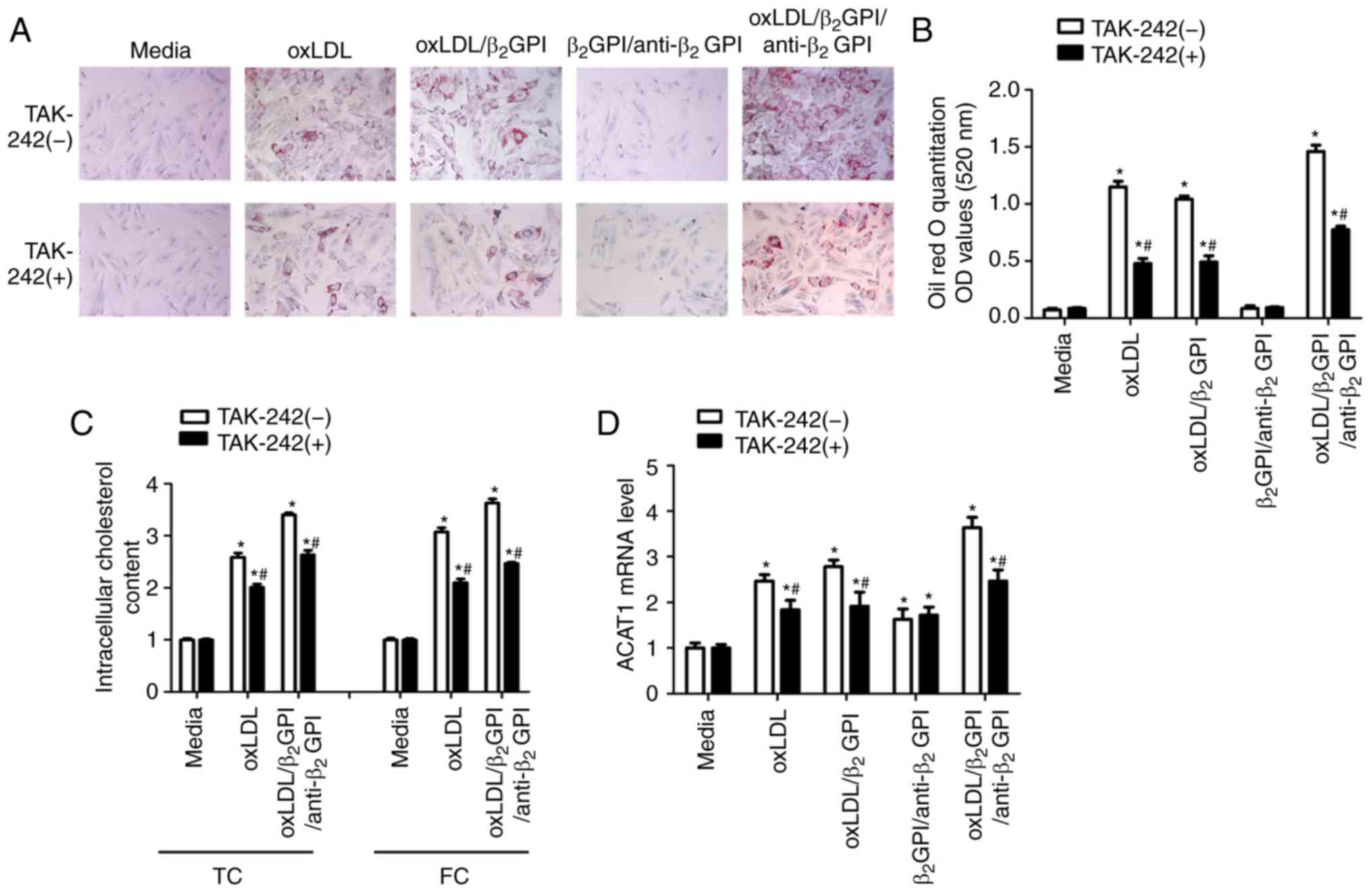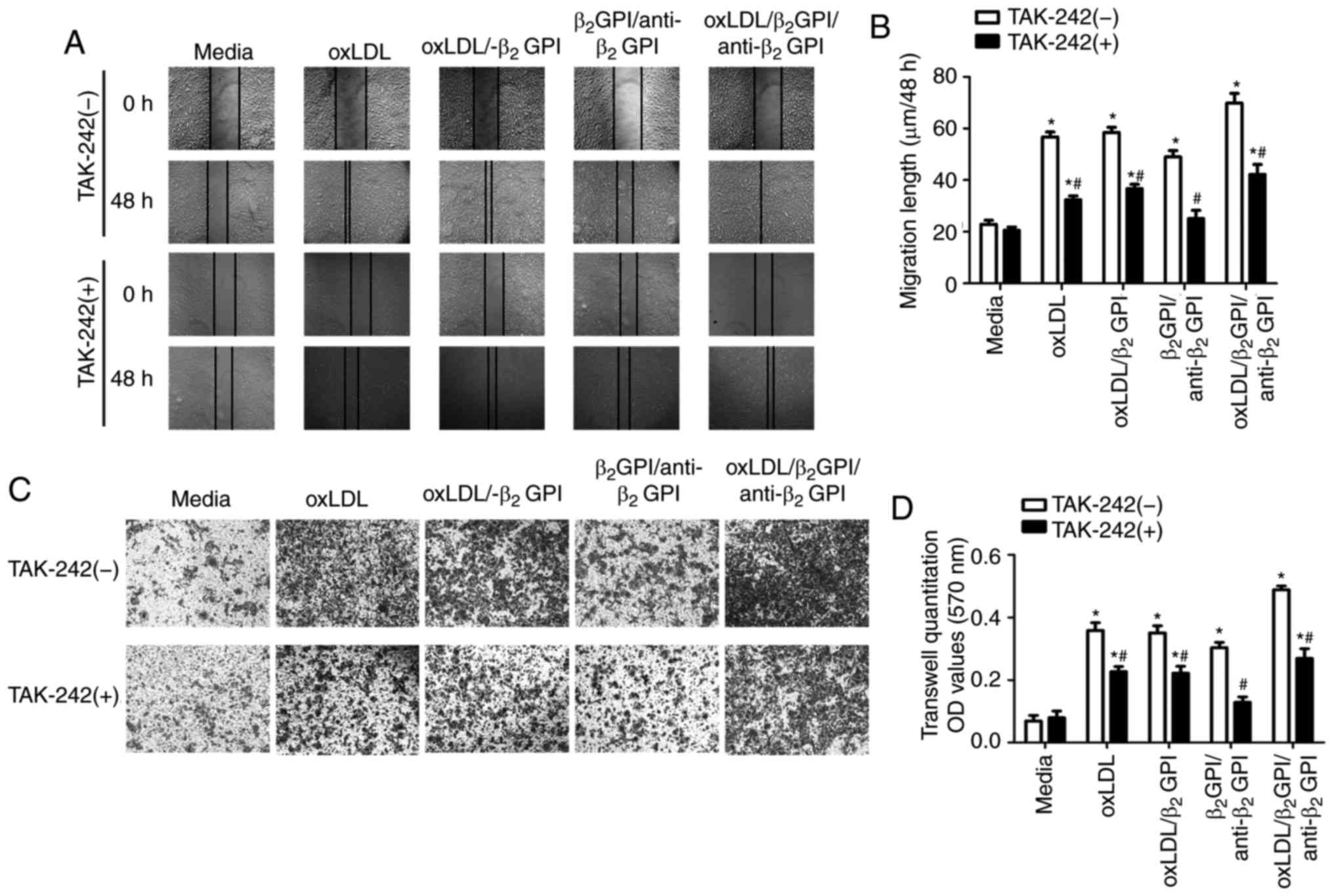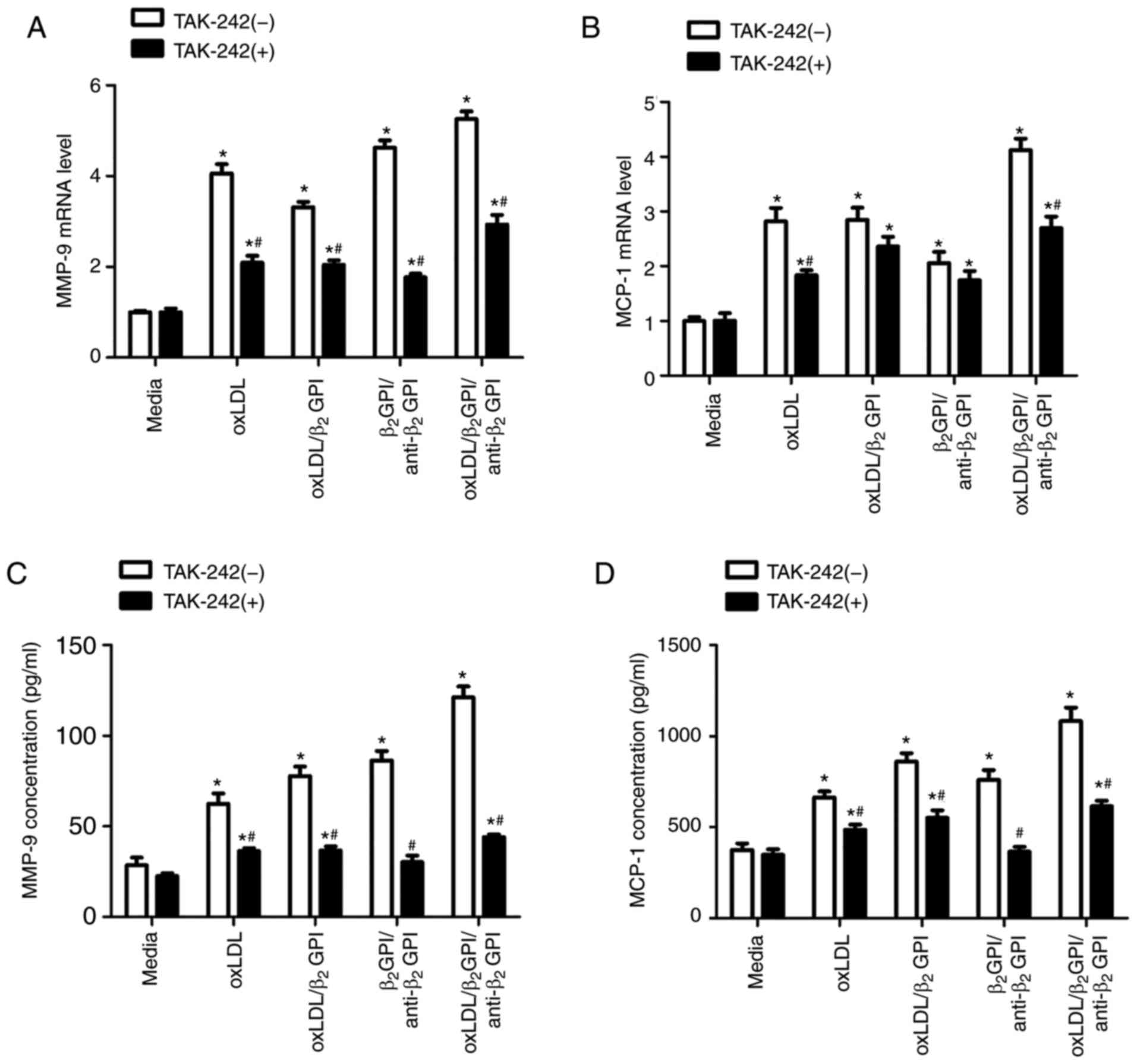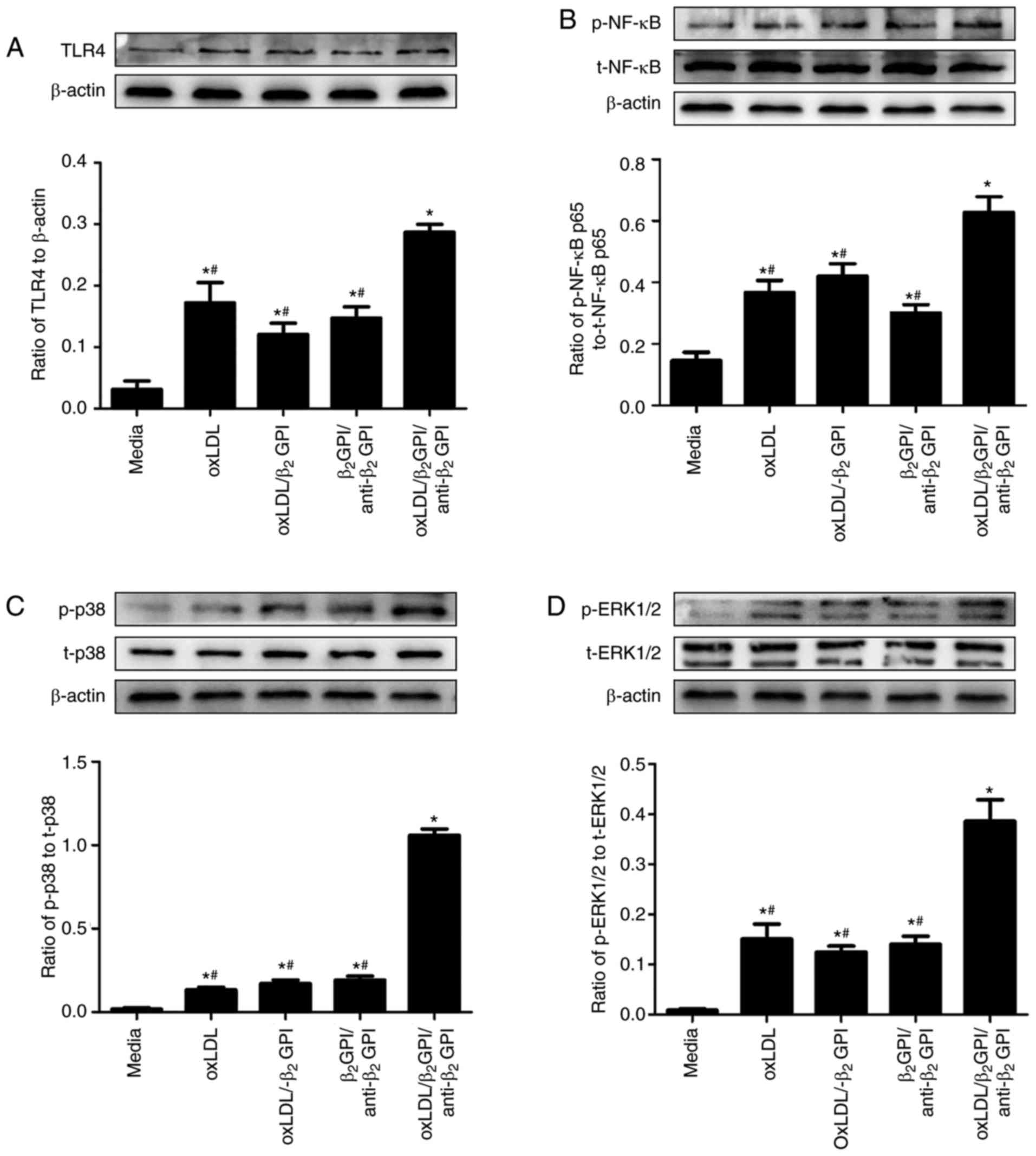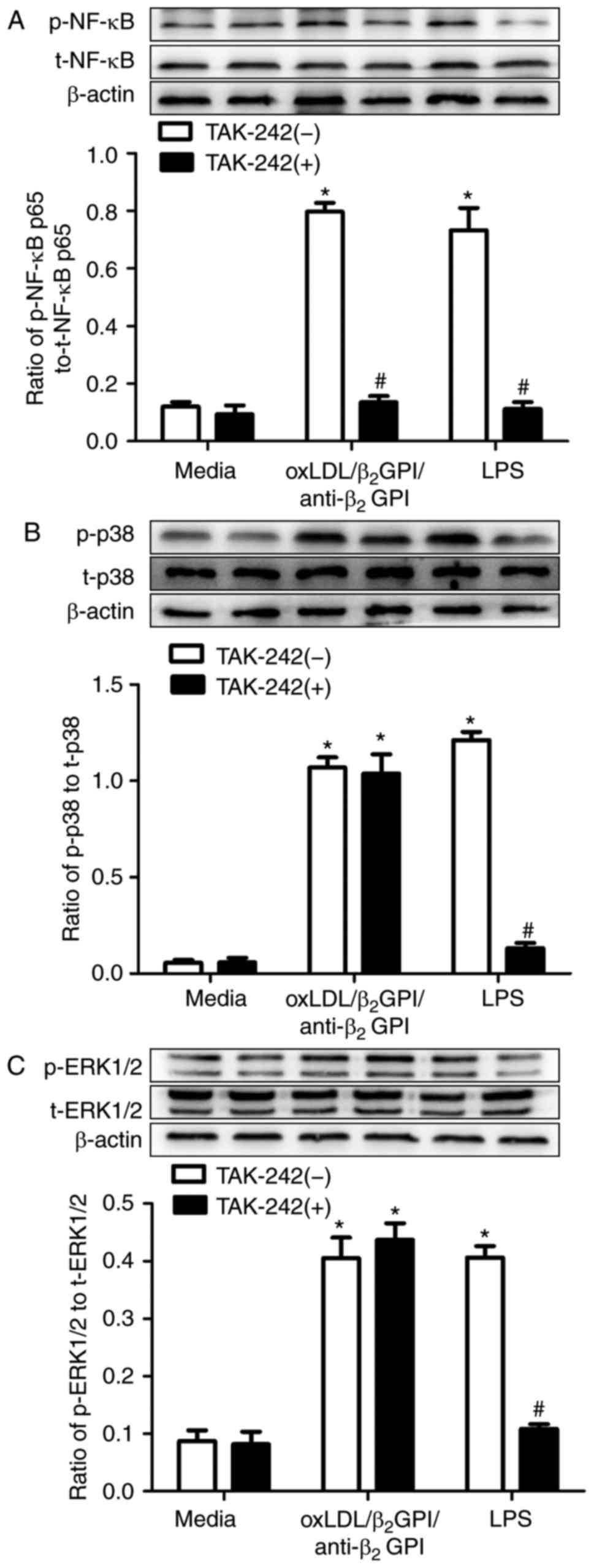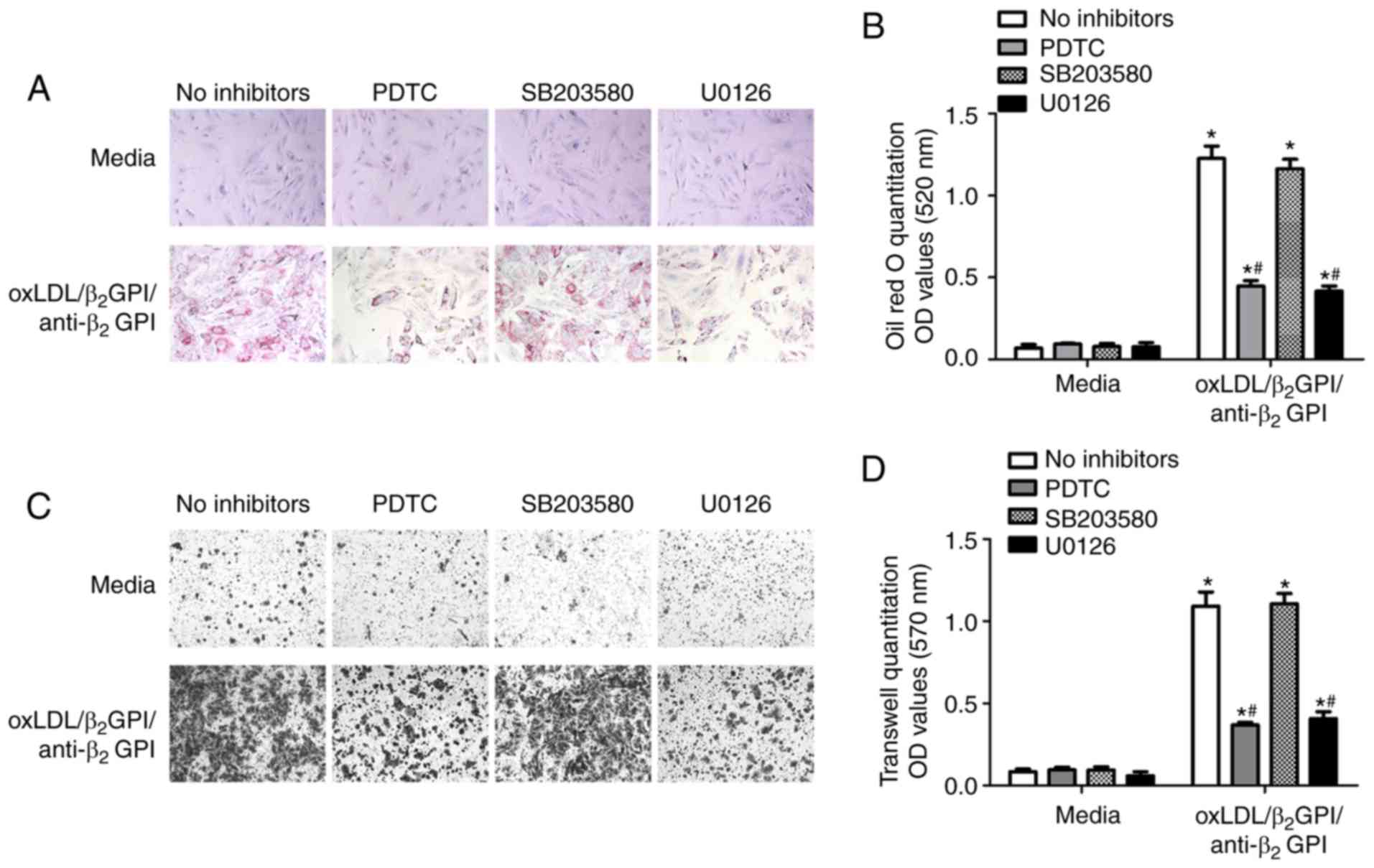|
1
|
Glass CK and Witztum JL: Atherosclerosis.
the road ahead. Cell. 104:503–516. 2001. View Article : Google Scholar : PubMed/NCBI
|
|
2
|
Amaya-Amaya J, Rojas-Villarraga A and
Anaya JM: Cardiovascular disease in the antiphospholipid syndrome.
Lupus. 23:1288–1291. 2014. View Article : Google Scholar : PubMed/NCBI
|
|
3
|
Matsuura E, Atzeni F, Sarzi-Puttini P,
Turiel M, Lopez LR and Nurmohamed MT: Is atherosclerosis an
autoimmune disease? BMC Med. 12:472014. View Article : Google Scholar : PubMed/NCBI
|
|
4
|
Stern C, Chamley L, Hale L, Kloss M,
Speirs A and Baker HW: Antibodies to beta2 glycoprotein I are
associated with in vitro fertilization implantation failure as well
as recurrent miscarriage: Results of a prevalence study. Fertil
Steril. 70:938–944. 1998. View Article : Google Scholar : PubMed/NCBI
|
|
5
|
Habe K, Wada H, Matsumoto T, Ohishi K,
Ikejiri M, Matsubara K, Morioka T, Kamimoto Y, Ikeda T, Katayama N,
et al: Presence of antiphospholipid antibody is a risk factor in
thrombotic events in patients with antiphospholipid syndrome or
relevant diseases. Intern Med. 97:345–350. 2013.
|
|
6
|
Amory CF, Levine SR, Brey RL,
Gebregziabher M, Tuhrim S, Tilley BC, Simpson AC, Sacco RL and Mohr
JP; APASS-WARSS Collaborators: Antiphospholipid antibodies and
recurrent thrombotic events: Persistence and portfolio. Cerebrovasc
Dis. 40:293–300. 2015. View Article : Google Scholar : PubMed/NCBI
|
|
7
|
Li J, Chi Y, Liu S, Wang L, Wang R, Han X,
Matsuura E and Liu Q: Recombinant domain V of
β2-glycoprotein I inhibits the formation of atherogenic
oxLDL/β2-glycoprotein I complexes. J Clin Immunol.
34:669–676. 2014. View Article : Google Scholar : PubMed/NCBI
|
|
8
|
Otomo K, Amengual O, Fujieda Y, Nakagawa
H, Kato M, Oku K, Horita T, Yasuda S, Matsumoto M, Nakayama KI, et
al: Role of apolipoprotein B100 and oxidized low-density
lipoprotein in the monocyte tissue factor induction mediated by
anti-β2 glyco-protein I antibodies. Lupus. 25:1288–1298.
2016. View Article : Google Scholar : PubMed/NCBI
|
|
9
|
Ouweneel AB and Van Eck M: Lipoproteins as
modulators of atherothrombosis, From endothelial function to
primary and secondary coagulation. Vascul Pharmacol. 82:1–10. 2016.
View Article : Google Scholar
|
|
10
|
Di Pietro N, Formoso G and Pandolfi A:
Physiology and pathophysiology of oxLDL uptake by vascular wall
cells in atherosclerosis. Vascul Pharmacol. 84:1–7. 2016.
View Article : Google Scholar : PubMed/NCBI
|
|
11
|
George J, Harats D, Gilburd B, Afek A,
Levy Y, Schneiderman J, Barshack I, Kopolovic J and Shoenfeld Y:
Immunolocalization of beta2-glycoprotein I (apolipoprotein H) to
human athero-sclerotic plaques: Potential implications for lesion
progression. Circulation. 99:2227–2230. 1999. View Article : Google Scholar : PubMed/NCBI
|
|
12
|
Yu R, Yuan Y, Niu D, Song J, Liu T, Wu J
and Wang J: Elevated beta2-glycoprotein I-low-density lipoprotein
levels are associated with the presence of diabetic microvascular
complications. J Diabetes Complications. 29:59–63. 2015. View Article : Google Scholar
|
|
13
|
Kasahara J, Kobayashi K, Maeshima Y,
Yamasaki Y, Yasuda T, Matsuura E and Makino H: Clinical
significance of serum oxidized low-density
lipoprotein/beta2-glycoprotein I complexes in patients with chronic
renal diseases. Nephron Clin Pract. 98:c15–c24. 2004. View Article : Google Scholar : PubMed/NCBI
|
|
14
|
Lopez D, Garcia-Valladares I,
Palafox-Sanchez CA, De La Torre IG, Kobayashi K, Matsuura E and
Lopez LR: Oxidized low-density lipoprotein/beta2-glycoprotein I
complexes and autoantibodies to oxLig-1/beta2-glycoprotein I in
patients with systemic lupus erythematosus and antiphospholipid
syndrome. Am J Clin Pathol. 121:426–436. 2004. View Article : Google Scholar : PubMed/NCBI
|
|
15
|
Matsuura E and Lopez LR: Are oxidized
LDL/beta2-glycoprotein I complexes pathogenic antigens in
autoimmune-mediated atherosclerosis? Clin Dev Immunol. 11:103–111.
2004. View Article : Google Scholar : PubMed/NCBI
|
|
16
|
Kobayashi K, Kishi M, Atsumi T,
Bertolaccini ML, Makino H, Sakairi N, Yamamoto I, Yasuda T,
Khamashta MA, Hughes GR, et al: Circulating oxidized LDL forms
complexes with beta2-glycoprotein I: Implication as an atherogenic
auto-antigen. J Lipid Res. 44:716–726. 2003. View Article : Google Scholar : PubMed/NCBI
|
|
17
|
Hasunuma Y, Matsuura E, Makita Z, Katahira
T, Nishi S and Koike T: Involvement of beta 2-glycoprotein I and
anticardiolipin antibodies in oxidatively modified low-density
lipoprotein uptake by macrophages. Clin Exp Immunol. 107:569–573.
1997. View Article : Google Scholar : PubMed/NCBI
|
|
18
|
Kobayashi K, Tada K, Itabe H, Ueno T, Liu
PH, Tsutsumi A, Kuwana M, Yasuda T, Shoenfeld Y, de Groot PG and
Matsuura E: Distinguished effects of antiphospholipid antibodies
and anti-oxidized LDL antibodies on oxidized LDL uptake by
macrophages. Lupus. 16:929–938. 2007. View Article : Google Scholar : PubMed/NCBI
|
|
19
|
Xu Y, Kong X, Zhou H, Zhang X, Liu J, Yan
J, Xie H and Xie Y: oxLDL/β2GPI/anti-β2GPI
complex induced macrophage differentiation to foam cell involving
TLR4/NF-kappa B signal transduction pathway. Thromb Res.
134:384–392. 2014. View Article : Google Scholar : PubMed/NCBI
|
|
20
|
Bassi N, Ghirardello A, Iaccarino L,
Zampieri S, Rampudda ME, Atzeni F, Sarzi-Puttini P, Shoenfeld Y and
Doria A: OxLDL/beta2GPI-anti-oxLDL/beta2GPI complex and
atherosclerosis in SLE patients. Autoimmun Rev. 7:52–58. 2007.
View Article : Google Scholar : PubMed/NCBI
|
|
21
|
Zhang X, Xie Y, Zhou H, Xu Y, Liu J, Xie H
and Yan J: Involvement of TLR4 in oxidized
LDL/β2GPI/anti-β2GPI-induced transformation
of macrophages to foam cells. J Atheroscler Thromb. 21:1140–1151.
2014. View Article : Google Scholar
|
|
22
|
Tabas I, García-Cardeña G and Owens GK:
Recent insights into the cellular biology of atherosclerosis. J
Cell Biol. 209:13–22. 2015. View Article : Google Scholar : PubMed/NCBI
|
|
23
|
Bennett MR, Sinha S and Owens GK: Vascular
smooth muscle cells in atherosclerosis. Circ Res. 118:692–702.
2016. View Article : Google Scholar : PubMed/NCBI
|
|
24
|
Chistiakov DA, Orekhov AN and Bobryshev
YV: Vascular smooth muscle cell in atherosclerosis. Acta
Physiol(Oxf). 214:33–50. 2015. View Article : Google Scholar
|
|
25
|
Hartman J and Frishman WH: Inflammation
and atherosclerosis: A review of the role of interleukin-6 in the
development of atherosclerosis and the potential for targeted drug
therapy. Cardiol Rev. 22:147–151. 2014. View Article : Google Scholar : PubMed/NCBI
|
|
26
|
Matsuura E, Lopez LR, Shoenfeld Y and Ames
PR: β2-glycoprotein I and oxidative inflammation in
early athero-genesis: A progression from innate to adaptive
immunity? Autoimmun Rev. 12:241–249. 2012. View Article : Google Scholar : PubMed/NCBI
|
|
27
|
Roshan MH and Tambo A: The role of TLR2,
TLR4, and TLR9 in the pathogenesis of atherosclerosis. Int J
Inflam. 2016:15328322016. View Article : Google Scholar : PubMed/NCBI
|
|
28
|
Hopkins PN: Molecular biology of
atherosclerosis. Physiol Rev. 93:1317–1542. 2013. View Article : Google Scholar : PubMed/NCBI
|
|
29
|
Yin YW, Liao SQ, Zhang MJ, Liu Y, Li BH,
Zhou Y, Chen L, Gao CY, Li JC and Zhang LL: TLR4-mediated
inflammation promotes foam cell formation of vascular smooth muscle
cell by upregulating ACAT1 expression. Cell Death Dis. 6:16592015.
View Article : Google Scholar : PubMed/NCBI
|
|
30
|
Yang K, Zhang XJ, Cao LJ, Liu XH, Liu ZH,
Wang XQ, Chen QJ, Lu L, Shen WF and Liu Y: Toll-like receptor 4
mediates inflammatory cytokine secretion in smooth muscle cells
induced by oxidized low-density lipoprotein. PloS One.
9:e959352014. View Article : Google Scholar : PubMed/NCBI
|
|
31
|
Kong F, Ye B, Cao J, Cai X, Lin L, Huang
S, Huang W and Huang Z: Curcumin represses NLRP3 inflammasome
activation via TLR4/MyD88/NF-κB and P2X7R signaling in PMA-induced
macrophages. Front Pharmacol. 7:3692016. View Article : Google Scholar
|
|
32
|
Jing Q, Xin SM, Cheng ZJ, Zhang WB, Zhang
R, Qin YW and Pei G: Activation of p38 mitogen-activated protein
kinase by oxidized LDL in vascular smooth muscle cells: Mediation
via pertussis toxin-sensitive g proteins and association with
oxidized LDL-induced cytotoxicity. Circ Res. 84:831–839. 1999.
View Article : Google Scholar : PubMed/NCBI
|
|
33
|
Livak KJ and Schmittgen TD: Analysis of
relative gene expression data using real-time quantitative PCR and
the 2(-Delta Delta C(T)) method. Methods. 25:402–408. 2001.
View Article : Google Scholar
|
|
34
|
Newby AC: Matrix metalloproteinases
regulate migration, proliferation, and death of vascular smooth
muscle cells by degrading matrix and non-matrix substrates.
Cardiovasc Res. 69:614–624. 2006. View Article : Google Scholar
|
|
35
|
Lin J, Kakkar V and Lu X: Impact of MCP-1
in atherosclerosis. Curr Pharm Des. 20:4580–4588. 2014. View Article : Google Scholar : PubMed/NCBI
|
|
36
|
Płóciennikowska A, Hromada-Judycka A,
Borzęcka K and Kwiatkowska K: Co-operation of TLR4 and raft
proteins in LPS-induced pro-inflammatory signaling. Cell Mol Life
Sci. 72:557–581. 2015. View Article : Google Scholar
|
|
37
|
Ross R and Glomset JA: Atherosclerosis and
the arterial smooth muscle cell: Proliferation of smooth muscle is
a key event in the genesis of the lesions of atherosclerosis.
Science. 180:1332–1339. 1973. View Article : Google Scholar : PubMed/NCBI
|
|
38
|
Badimon L and Vilahur G: Thrombosis
formation on athero-sclerotic lesions and plaque rupture. J Intern
Med. 276:618–632. 2014. View Article : Google Scholar : PubMed/NCBI
|
|
39
|
Sima P, Vannucci L and Vetvicka V:
Atherosclerosis as autoimmune disease. Ann Transl Med. 6:1162018.
View Article : Google Scholar : PubMed/NCBI
|
|
40
|
Tanaka N, Masuoka S, Kusunoki N, Nanki T
and Kawai S: Serum resistin level and progression of
atherosclerosis during glucocor-ticoid therapy for systemic
autoimmune diseases. Metabolites. 6:E282016. View Article : Google Scholar
|
|
41
|
Rosenfeld ME and Ross R: Macrophage and
smooth muscle cell proliferation in atherosclerotic lesions of WHHL
and comparably hypercholesterolemic fat-fed rabbits.
Arteriosclerosis. 10:680–687. 1990. View Article : Google Scholar : PubMed/NCBI
|
|
42
|
Suckling KE and Strange EF: Role of
acyl-CoA: Cholesterol acyltransferase in cellular cholesterol
metabolism. J Lipid Res. 26:647–671. 1985.PubMed/NCBI
|
|
43
|
Rudel LL, Lee RG and Cockman TL: Acyl
coenzyme A: Cholesterol acyltransferase types 1 and 2: Structure
and function in atherosclerosis. Curr Opin Lipidol. 12:121–127.
2001. View Article : Google Scholar : PubMed/NCBI
|
|
44
|
Sakashita N, Miyazaki A, Takeya M,
Horiuchi S, Chang CC, Chang TY and Takahashi K: Localization of
human acyl-coenzyme A: Cholesterol acyltransferase-1 (ACAT-1) in
macrophages and in various tissues. Am J Pathol. 156:227–236. 2000.
View Article : Google Scholar : PubMed/NCBI
|
|
45
|
Dai Y, Cao Y, Zhang Z, Vallurupalli S and
Mehta JL: Xanthine oxidase induces foam cell formation through
LOX-1 and NLRP3 activation. Cardiovasc Drugs Ther. 31:19–27. 2017.
View Article : Google Scholar : PubMed/NCBI
|
|
46
|
Yang J, Jian R, Yu J, Zhi X, Liao X, Yu J
and Zhou P: CD73 regulates vascular smooth muscle cell functions
and facilitates atherosclerotic plaque formation. IUBMB Life.
67:853–860. 2015. View Article : Google Scholar : PubMed/NCBI
|
|
47
|
Kim J and Ko J: Human sLZIP promotes
atherosclerosis via MMP-9 transcription and vascular smooth muscle
cell migration. FASEB J. 28:5010–5021. 2014. View Article : Google Scholar : PubMed/NCBI
|
|
48
|
Chae IG, Yu MH, Im NK, Jung YT, Lee J,
Chun KS and Lee IS: Effect of Rosemarinus officinalis L. on MMP-9,
MCP-1 levels, and cell migration in RAW 264.7 and smooth muscle
cells. J Med Food. 15:879–886. 2012. View Article : Google Scholar : PubMed/NCBI
|
|
49
|
Xie HX, Zhou H, Wang HB, Chen DD, Xia LF,
Wang T and Yan JC: Anti-β(2)GPI/β(2)GPI induced TF and TNF-α
expression in monocytes involving both TLR4/MyD88 and TLR4/TRIF
signaling pathways. Mol Immunol. 53:246–254. 2013. View Article : Google Scholar
|
|
50
|
Cheng YC, Sheen JM, Hu WL and Hung YC:
Polyphenols and oxidative stress in atherosclerosis-related
ischemic heart disease and stroke. Oxid Med Cell Longev.
2017:85264382017. View Article : Google Scholar
|
|
51
|
Chaabane C, Coen M and Bochaton-Piallat
ML: Smooth muscle cell phenotypic switch: implications for foam
cell formation. Curr Opin Lipidol. 25:374–379. 2014. View Article : Google Scholar : PubMed/NCBI
|















